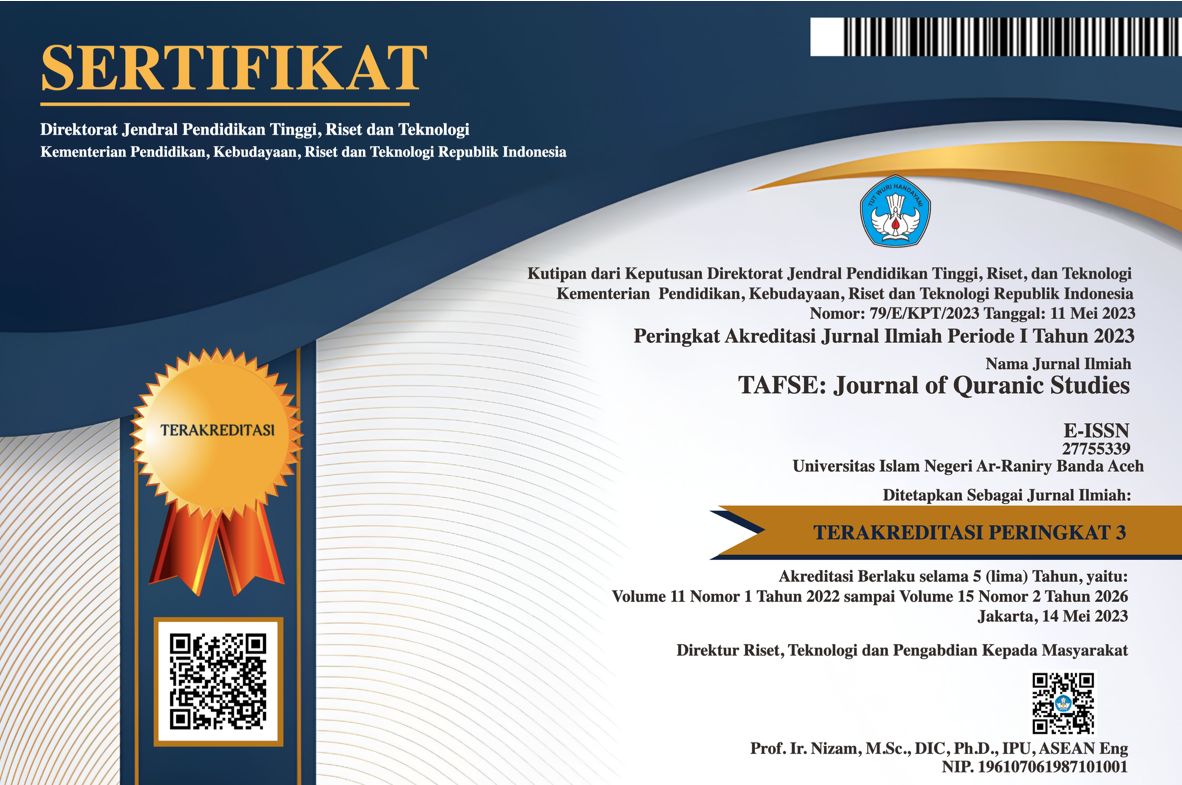The Philosophy of Mountains in the Qur’an and Its Lessons on Stability, Resilience, and Environmental Ethics
DOI:
https://doi.org/10.22373/tafse.v9i2.29034Keywords:
Qur’an, mountains, cosmic balance (mīzān), environmental ethicsAbstract
The Qur’an presents mountains not only as geological formations but as profound symbols of cosmic balance (mīzān), spiritual resilience, and divine wisdom. This study examines their philosophical significance by integrating classical and modern Qur’anic exegesis (tafsir) with contemporary environmental ethics and scientific perspectives. Employing a qualitative approach with thematic and comparative tafsir analysis, this research explores Qur’anic references to mountains (jabal, rawāsi, ṭūr) through interpretations by Al-Tabari, Ibn Kathir, Al-Razi, and M. Quraish Shihab. Findings indicate that mountains function as both stabilizers of the earth and metaphors for human endurance, patience, and revelation. Their Qur’anic depiction aligns with the concept of mīzān (divine balance), illustrating the interconnectedness between natural order and moral responsibility. Additionally, the study emphasizes human stewardship (khalīfah fil ard’) and ethical responsibility toward nature, drawing links between Islamic teachings and contemporary sustainability discourse. By bridging scriptural interpretation with ecological thought, this study underscores how the Qur’anic philosophy of mountains provides ethical insights into environmental conservation.
Downloads
References
Al-Razi, Fakhruddin. Mafatih Al-Ghayb. Vol. 2. Beirut: Dar al-Kutub al-Ilmiah, 2000.
Al-Tabari, Abu Ja’far Muhamaad Ibn Jarir. Jami’ Al-Bayan Fi Ta’wil Al-Qur’an. Vol. 16. Beirut: Muassasah al-Risalah, 2000.
Arifin, Samsul. “Gunungn Dalam Al-Qur’an.” UIN Sunan Kalijaga, Yogyakarta, 2015. https://digilib.uin-suka.ac.id/id/eprint/17244/.
Arzy, Shahar, Moshe Idel, Theodor Landis, and Olaf Blanke. “Why Revelations Have Occurred on Mountains?” Medical Hypotheses 65, no. 5 (January 2005): 841–45. https://doi.org/10.1016/j.mehy.2005.04.044.
Bernbaum, Edwin. “The Spiritual and Cultural Importance of Mountains,” 213–24, 2022. https://doi.org/10.1007/978-3-031-13298-8_12.
Durà-Vilà, Glòria, and Gerard Leavey. “Solitude among Contemplative Cloistered Nuns and Monks: Conceptualisation, Coping and Benefits of Spiritually Motivated Solitude.” Mental Health, Religion & Culture 20, no. 1 (January 2, 2017): 45–60. https://doi.org/10.1080/13674676.2017.1322049.
El-Naggar, Z. The Geological Concept of Mountains in the Quran. Al-Falah Foundation, 2003.
Gobaili Saged, Ali Ali, Thabet Ahmad Abu Alhaj, and Mohd Yakub Zulkifli Bi. “The Role of the Maqās․id Al-Sharīʿah in Preserving the Environment.” Humanomics 33, no. 2 (May 8, 2017): 125–32. https://doi.org/10.1108/H-12-2016-0105.
Harden, Carol P., and Alfonso Fernández. “Mountain Waterscapes: Geographies of Interactions, Transformations, and Meanings,” 275–92, 2022. https://doi.org/10.1007/978-3-031-13298-8_16.
Helfaya, Akrum, Amr Kotb, and Rasha Hanafi. “Qur’anic Ethics for Environmental Responsibility: Implications for Business Practice.” Journal of Business Ethics 150, no. 4 (July 9, 2018): 1105–28. https://doi.org/10.1007/s10551-016-3195-6.
Hu, Ang, Jianjun Wang, Hang Sun, Bin Niu, Guicai Si, Jian Wang, Chih-Fu Yeh, et al. “Mountain Biodiversity and Ecosystem Functions: Interplay between Geology and Contemporary Environments.” The ISME Journal 14, no. 4 (April 1, 2020): 931–44. https://doi.org/10.1038/s41396-019-0574-x.
Huang, Jinghua, Chujing Yang, and Si Chen. “Spatial Imagination in Sacred Narratives of Mountain Communities in Western Yunnan, China.” Religions 15, no. 3 (March 21, 2024): 382. https://doi.org/10.3390/rel15030382.
Ibn Kathir, Isma’il ibn ’Umar Al-Dimasyqiy. Tafsīr Al-Qur’ān Al-‘Aẓīm. Vol. 1. Giza: Mu’assasah Qarḍaba, 2000.
Ibrahim, Mohamed Akhiruddin. “MOUNTAINS AS STABILIZERS FOR EARTH FROM THE QURANIC AND MODERN SCIENCE PERSPECTIVES.” IJASOS- International E-Journal of Advances in Social Sciences 5, no. 15 (December 29, 2019): 1287–92. https://doi.org/10.18769/ijasos.592092.
Jaffer, Tariq. Rāzī Master of Quranic Interpretation and Theological Reasoning. Oxford University Press, 2015.
Jo, Hyunju, Chorong Song, and Yoshifumi Miyazaki. “Physiological Benefits of Viewing Nature: A Systematic Review of Indoor Experiments.” International Journal of Environmental Research and Public Health 16, no. 23 (November 27, 2019): 4739. https://doi.org/10.3390/ijerph16234739.
Kafrawi, Shalahudin. “Fakhr Al-Dīn Al-Rāzī’s Methodology in Interpreting the Qur’ān.” McGill University, 1999. https://search.proquest.com/dissertations-theses/fakhr-al-dīn-rāzīs-methodology-interpreting-qurān/docview/304558595/se-2?accountid=159111.
Mårtensson, Ulrika. “Revelation and Prophecy in the Qur’an.” In The Oxford Handbook of Qur’anic Studies, edited by Muhammad Abdel Haleem and Mustafa Shah, 417–29. Oxford University Press, 2020. https://doi.org/10.1093/oxfordhb/9780199698646.013.34.
Meliyana, Fitria Susan, and Aqiel Sifa’ Abdallah Putra. “IMPLEMENTATION OF SURAH AL-A’RAF VERSES 56-58 AS THE SUSTAINABLE LIFESTYLE BASED ON ECOSUFISM PARADIGM.” Al-Munir: Jurnal Studi Ilmu Al-Qur’an Dan Tafsir 6, no. 2 (October 2024): 175–94. https://doi.org/10.24239/AL-MUNIR.V6I2.932.
Mok, Magdalena Mo Ching, Wen-Chung Wang, Ying-Yao Cheng, Shing-On Leung, and Li-Ming Chen. “Prevalence and Behavioral Ranking of Bullying and Victimization Among Secondary Students in Hong Kong, Taiwan, and Macao.” The Asia-Pacific Education Researcher 23, no. 3 (September 1, 2014): 757–67. https://doi.org/10.1007/s40299-013-0151-4.
Muhamad, Asmawati, Abdul Halim Syihab, and Abdul Halim Ibrahim. “Preserving Human–Nature’s Interaction for Sustainability: Quran and Sunnah Perspective.” Science and Engineering Ethics 26, no. 2 (April 11, 2020): 1053–66. https://doi.org/10.1007/s11948-020-00192-7.
Mustakim. “Pendidikan Lingkungan Dan Implementasi Dalam Pendidikan Islam (Analisis Surat Al-A’raf Ayat 56-58 Tafsir Al Misbah Karya M. Quraish Shihab.” Journal of Islamic Education (JIE) 2 (1), no. 1 (2017). https://ejournal.stitmuhbangil.ac.id/index.php/jie/article/view/42.
Naor, Lia, and Ofra Mayseless. “The Wilderness Solo Experience: A Unique Practice of Silence and Solitude for Personal Growth.” Frontiers in Psychology 11 (September 10, 2020). https://doi.org/10.3389/fpsyg.2020.547067.
Norita Mohd Nasir, Mahendhiran Sanggaran Nair, and Pervaiz Khalid Ahmed. “Environmental Sustainability and Contemporary Islamic Society: A Shariah Perspective.” Asian Academy of Management Journal 27, no. 2 (December 7, 2022). https://doi.org/10.21315/aamj2022.27.2.10.
Pradana, Rendy, Lukmanul Hakim, Muhammad Hapis Harahap, Novianri Novianri, and Yandri Agusta Putra. “GUNUNG DALAM TAFSIR ILMI (ANALISIS MELALUI PENDEKATAN GEOGRAFI).” Jurnal Al-Mubarak: Jurnal Kajian Al-Qur’an Dan Tafsir 9, no. 2 (December 2024): 35–49. https://doi.org/https://doi.org/10.47435/al-mubarak.v7i1.
Rahaju Ningtyas, Nurhikmah Paddiyatu, Benny Novico Zani, Herawati, and Sandy Novryanto Sakati. “The Impact of Nature Exposure on Mental Health and Well-Being.” West Science Interdisciplinary Studies 1, no. 08 (August 29, 2023): 543–50. https://doi.org/10.58812/wsis.v1i08.173.
Rifaannudin, Mahmud. “Manfaat Tumbuhan Dalam Al Qur’an Bagi Kesehatan (Pendekatan Tafsir Ilmi).” Al-Muhafidz 2, no. 1 (2022): 87–100.
Saad, Bendaoud. “Mountains Gravitational Pegs Stabilize the Earth’s Rotation Motion.” Emirati Journal of Space Science 1, no. 1 (May 25, 2023): 4–25. https://doi.org/10.54878/EJSS.287.
Saputra, Ayu Riski. “Gunung Dan Fungsinya Dalam Al-Qur’an Dan Relevansinya Dengan Ilmu Geologi (Kajian Tafsir Ilmi Kementerian Agama Republik Indonesia).” UIN Sultan Syarif Kasim Riau, 2020.
Shihab, M. Quraish. Tafsir Al-Miṣbāh. Jakarta: Lentera Hati, 2012.
Syarifah, Umaiyatus, Jauhar Azizy, and Sihabussalam Sihabussalam. “Environmental Conservation in Quraish Shihab and Hamka’s Perspective.” Islamadina : Jurnal Pemikiran Islam, September 1, 2024, 114. https://doi.org/10.30595/islamadina.v0i0.19625.
Tefera, Gebrekidan Worku, Ram L. Ray, and Amare Bantider. “Exploring the Unique Biophysical Characteristics and Ecosystem Services of Mountains: A Review.” Journal of Mountain Science 21, no. 11 (November 13, 2024): 3584–97. https://doi.org/10.1007/s11629-024-8828-0.
Wasilah, Rifqoh, and Ruslan Hayeewaji. “ECOLOGICAL BALANCE IN THE QUR’AN: A THEMATIC REVIEW OF VERSES ON CLIMATE CHANGE MITIGATION AND ADAPTATION.” MUSHAF: Jurnal Tafsir Berwawasan Keindonesiaan 4, no. 2 (2024): 85–101. https://ejournal.unuja.ac.id/index.php/mushaf/article/view/9217.
Zhang, Lin, and Jinniu Wang. “Mountain Biodiversity, Species Distribution and Ecosystem Functioning in a Changing World.” Diversity 15, no. 7 (June 22, 2023): 799. https://doi.org/10.3390/d15070799.
Downloads
Published
Issue
Section
License
Authors who publish with this journal agree to the following terms:
- Authors retain copyright and grant the journal right of first publication with the work simultaneously licensed under a Creative Commons Attribution License (CC BY NC 4.0) that allows others to share the work with an acknowledgment of the work's authorship and initial publication in this journal.
- Authors are able to enter into separate, additional contractual arrangements for the non-exclusive distribution of the journal's published version of the work (e.g., post it to an institutional repository or publish it in a book), with an acknowledgment of its initial publication in this journal.
- Authors are permitted and encouraged to post their work online (e.g., in institutional repositories or on their website) prior to and during the submission process, as it can lead to productive exchanges, as well as earlier and greater citation of published work (See The Effect of Open Access).





